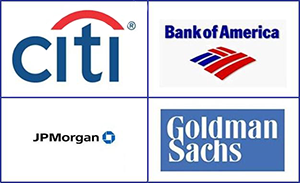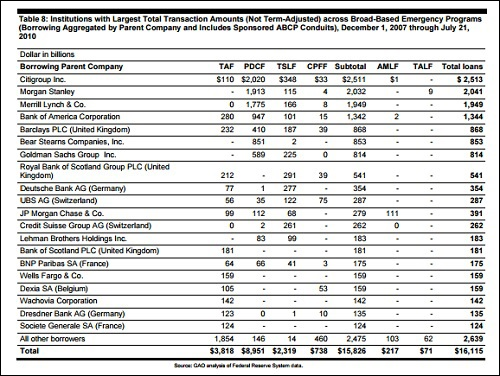By Pam Martens and Russ Martens: June 24, 2019 ~
 As of March 31 of this year, there were 5,362 Federally-insured commercial banks and savings associations in the United States. Just two of these banks, JPMorgan Chase NA and Citibank NA control 75.7 percent of all precious metals derivatives contracts held by all of the 5,362 Federally-insured banks and savings associations. This finding comes from a report released last week by the regulator of national banks, the Office of the Comptroller of the Currency (OCC). (See Table 9 in the Appendix of the OCC report.)
As of March 31 of this year, there were 5,362 Federally-insured commercial banks and savings associations in the United States. Just two of these banks, JPMorgan Chase NA and Citibank NA control 75.7 percent of all precious metals derivatives contracts held by all of the 5,362 Federally-insured banks and savings associations. This finding comes from a report released last week by the regulator of national banks, the Office of the Comptroller of the Currency (OCC). (See Table 9 in the Appendix of the OCC report.)
Commercial banks are supposed to be making safe and sound business loans to keep the U.S. economy humming, creating good-paying jobs and making America competitive around the world. But according to the latest OCC report, of the $38.57 billion held in precious metals derivative contracts by all Federally-insured banks and savings associations in the U.S., JPMorgan Chase Bank NA held $17.509 billion and Citibank NA held $11.691 billion. JPMorgan Chase is currently under a criminal probe by the U.S. Department of Justice involving precious metals trades.
Equally concerning, the trading of precious metals derivative contracts by Federally-insured banks has grown exponentially since 2001. At that time it represented less than $5 billion. During the financial crisis in 2008 and 2009, precious metals derivative contracts at the banks were less than $15 billion. They have more than doubled since that time.
The weirdness doesn’t stop there. According to the latest OCC report, JPMorgan Chase Bank NA holds $2.4 trillion in stock (equity) derivative contracts – which represents 64 percent of all stock derivative contracts held by all 5,362 Federally-insured banks in the United States. If you include the stock derivative contracts held by Citibank, Goldman Sachs Bank USA (yes, the Great Vampire Squid is allowed by its regulators to own a Federally-insured bank) and Bank of America NA, together with the stock derivative contracts held by JPMorgan Chase Bank, you have 93 percent of all equity derivative contracts held by all 5,362 Federally-insured banks in the U.S. (See Table 10 in the Appendix of the latest OCC report.)
Why do these four banks need to trade high-risk stock derivatives in their taxpayer-backstopped, Federally-insured banks while the vast majority of other Federally-insured banks do not? There are two reasons. The first being that their lapdog regulators and a timid Congress are allowing them to do it. The second reason is that these are really high-risk Wall Street investment banks and brokerage firms in drag as staid, prudent, deposit-taking commercial banks. As a result of the repeal of the 66-year old Glass-Steagall Act in 1999 under the Wall Street-cozy administration of President Bill Clinton, these Wall Street trading behemoths are now allowed to own Federally-insured commercial banks and do pretty much anything they want with the Mom and Pop deposits held in those banks.
We do not say “pretty much anything they want” without solid evidence to back that up. Four years after the greatest Wall Street crash since the Great Depression, JPMorgan Chase was found to have used hundreds of billions of dollars of its depositors’ money to make wild gambles in exotic derivatives in London. It lost at least $6.2 billion of its depositors’ money on those gambles. The bank paid over $1 billion in fines to U.S. and U.K. regulators over the matter which became known as the “London Whale.” The OCC found that the trades “constituted recklessly unsafe and unsound practices,” and “was part of a pattern of misconduct.”
After an in-depth investigation and scathing report from the U.S. Senate’s Permanent Subcommittee on Investigations, one would have thought that Congress would have reined in the derivative trading activities of Federally-insured banks. It did not. Instead, Congress has allowed the situation to grow even worse.
Today, the Federally-insured banking unit of JPMorgan Chase holds an unfathomable $59 trillion notional (face amount) in derivatives, which is up more than $10 trillion from its derivative holdings on December 31, 2018.
Citigroup’s Federally-insured commercial bank, Citibank, holds $51.2 trillion as of March 31, 2019 which is $19 trillion more than it held at the time it blew itself up in the last quarter of 2008. (See Table 1 in Appendix of the OCC report for the last quarter of 2008.)
In the midst of the Wall Street crash, on November 28, 2008, we wrote the following about Citigroup’s condition:
“Citigroup’s five-day death spiral last week was surreal. I know 20-something newlyweds who have better financial backup plans than this global banking giant. On Monday came the Town Hall meeting with employees to announce the sacking of 52,000 workers. (Aren’t Town Hall meetings supposed to instill confidence?) On Tuesday came the announcement of Citigroup losing 53 per cent of an internal hedge fund’s money in a month and bringing $17 billion of assets that had been hiding out in the Cayman Islands back onto its balance sheet. Wednesday brought the cheery news that a law firm was alleging that Citigroup peddled something called the MAT Five Fund as ‘safe’ and ‘secure’ only to watch it lose 80 per cent of its value. On Thursday, Saudi Prince Walid bin Talal, from that visionary country that won’t let women drive cars, stepped forward to reassure us that Citigroup is ‘undervalued’ and he was buying more shares. Not having any Princes of our own, we tend to associate them with fairytales. The next day the stock dropped another 20 percent with 1.02 billion shares changing hands. It closed at $3.77.
“Altogether, the stock lost 60 per cent last week and 87 percent this year. The company’s market value has now fallen from more than $250 billion in 2006 to $20.5 billion on Friday, November 21, 2008. That’s $4.5 billion less than Citigroup owes taxpayers from the U.S. Treasury’s bailout program.”
Think about that for a moment. Citigroup received the largest taxpayer bailout in global banking history, on top of $2.5 trillion in secret, below-market-rate revolving loans that were being sluiced to it from 2007 to mid 2010 by the Federal Reserve. (See chart below from the Government Accountability Office report.) And yet, today, it has been allowed by Congress and its regulators to remake itself into a high-risk derivatives casino.
In addition to the mushrooming derivatives at JPMorgan Chase and Citibank, the current OCC report also shows that the Federally-insured Goldman Sachs Bank USA holds $47 trillion in derivatives; and Bank of America’s Federally-insured bank, Bank of America NA, holds $20.4 trillion. Just those four Federally-insured banks hold 88.3 percent of the derivative contracts held by all 5,362 taxpayer-backstopped banks and savings associations in the U.S. (See Table 3 in the Appendix of the OCC report.)
This situation is screaming for attention and yet the Senate Banking Committee (controlled by the Republican majority in the Senate) and the House Financial Services Committee (controlled by the Democrat majority) have failed to hold any meaningful hearings into the matter.
There were scattered hearings in 2013 and 2014 into the vast physical commodity holdings of these same Wall Street banks. At a Senate hearing on July 24, 2013 Senator Sherrod Brown said this:
“Do the benefits of combining these activities outweigh the harm to consumers and manufacturers? Can regulators or the public fully understand these large, complex financial institutions and the risks to which these firms are exposing themselves – and the rest of society? Are the laws and regulations sufficiently stringent and transparent, and are regulators enforcing them aggressively enough? And what do we want our banks to do – make small business loans or refine and transport oil? Issue mortgages or corner the metals market?”
There was no need to ask that question. The financial collapse of Wall Street in 2008 from its dubious trading and derivatives dealings and the ensuing collapse of the U.S. economy had settled that debate in the public’s mind. It’s long past the time for Congress to hold meaningful hearings and subpoena documents.


